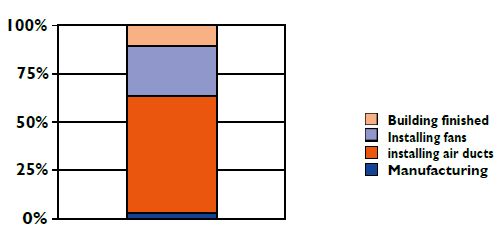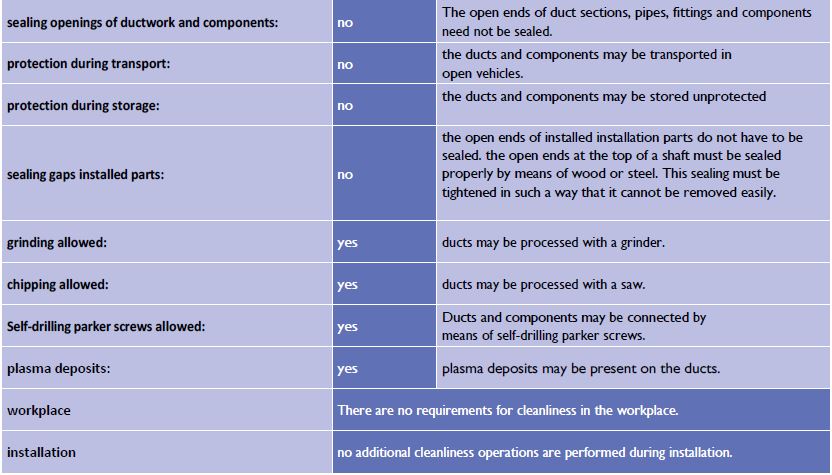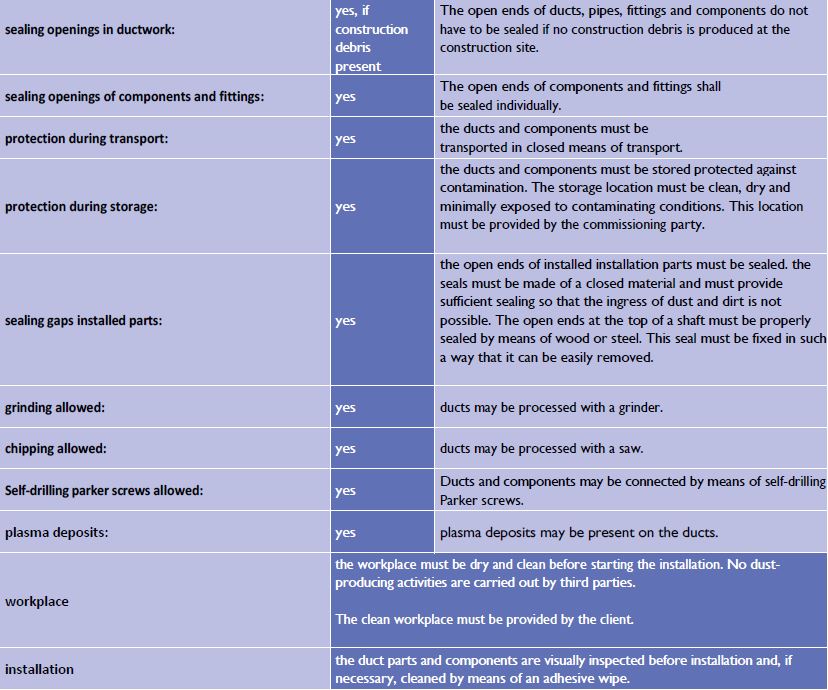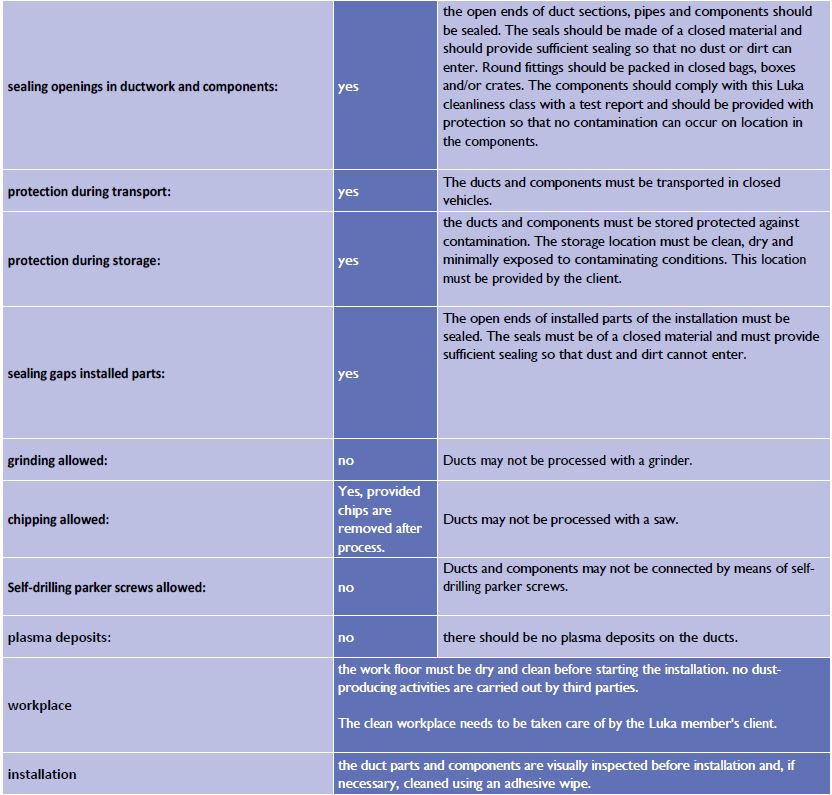2.12.1 General
The presence of dirt inside air transport routes during construction and before completion of new installations is increasingly being considered unacceptable. After being put into service, this dirt can have a negative impact on the service life of the system and system components and can also have a negative impact on the indoor air quality in buildings.
Internal contamination of the air transport routes in new installations in buildings occurs at various stages of the construction process, namely:
- Production externally and supply of the components of the air transport route;
- Storage of the components of the air transport route at the construction site;
- Installation/assembly of the air transport route;
- Completion of the building after completion of air transport routes;
- Building heat supply and trial run of the plant before transfer.
Figure 1 shows indicatively what the different stages in a standard process without special provisions contribute to the internal contamination of the air ducts.

Most contamination occurs during the installation process of the air transport route at the construction site. The Luka members can reduce this pollution to a large extent by taking adequate measures. Internal contamination can still be caused by the destructive and polluting influence of third parties at the construction site during the installation of the air transport route and by polluting activities after the installation of the air transport route.
A Luka-member cannot be held responsible for this last mentioned pollution, of which he is not the cause.
Luka however feels socially involved in realizing internally clean air transport routes as far as this lies within our possibilities.
This chapter has been prepared for those involved in the process of building air transport routes, who have also set themselves the goal of achieving internally clean air transport routes.
To this end, the following topics are described in this chapter:
- Research Luka and European standard NEN EN 15780;
- Luka Cleanliness Classes;
- Responsibilities of those involved in obtaining internally clean air transportroutes;
- Recommendations inspection hatches;
- Specifications;
- Recommendations for executive Luka members;
- Measuring the Luka Cleanliness Class;
- Measurement report Luka internal cleanliness class.
2.12.2 Research Luka and European standard NEN-EN 15780
In addition to visual inspections by the client and/or delegated client, Luka conducted research among designers of installations, standards and measuring methods.
This has resulted in the choice for standard ISO 8502-3 and the corresponding test method, because of the simplicity, unambiguousness and the possibility to perform the "Tape Test" on site, as described in ISO 8502-3.
The Luka cleanliness class is in no way connected to the NEN-EN 15780 standard. The NEN norm uses contamination levels in grams per m² of surface area. Luka uses contamination based on a comparison. The advantage of this is that the weight of the undesired contamination is not included in the assessment of the quantities of dust.
2.12.3 Luka Cleanliness Classes
Luka uses three internal cleanliness classes (Luka Reinheidsklassen, LR):
Luka Cleanliness Class L (LR-L): Low
Luka Cleanliness Class M (LR-M): Medium
Luka Cleanliness Class H (LR-H): High
The Luka Cleanliness Class is not automatically linked to the Luka Airtightness Class and must be described separately in the specifications or basic principles. However, the Luka Cleanliness Classes are directly linked to and based on the international standard ISO 8502-3. This ISO standard uses five dust quantity ratings.
These have been implemented in the Luka Cleanliness Classes as follows:
LR - L: ISO 8502-3, dust quantity rating 5 and higher.
LR - M: ISO 8502-3, dust quantity rating 3 and 4.
LR - H: ISO 8502-3, dust quantity rating 1 and 2.
2.12.4 Responsibilities of those involved in obtaining internally clean air transport routes.
It will be clear that the Luka member can only be held responsible for the internal cleanliness of the air transport routes to the extent that the Luka member is allowed and able to check and control the conditions under which the activities can be executed.
Responsibilities of those involved in obtaining internally clean air transport routes include:
- Construction site
The construction site gives a good indication of the cleanliness of the ducts. At a cleaned-up construction site, the work is cleaner and this results in cleaner installations. - Storage
Material storage should be allocated in such a way that it is not in the vicinity of polluting building processes. This is described in more detail in the Luka Quality Guide in chapter "Assembly instructions". - Planning
Coordination of the work of the various disciplines affects clean installations. Polluting activities should be carried out separately in terms of time from clean installation activities.
If the air treatment installation has to be put into operation during the building process, additional provisions may be required. Temporary filters may need to be installed by third parties to protect the return ducts.
2.12.5 Recommendation inspection hatches
To be able to inspect the installation properly, sufficient inspection hatches are required. The hatches must be fitted in the right place and be of sufficient size. Components with inspection hatches are preferred. In addition to the hatch for components requiring service, which are not fitted with an inspection hatch, it is recommended that additional hatches are fitted at shafts, technical rooms and story’s. The hatches must be easily accessible and clearly indicated on the drawing by the coordinating party. NEN-EN 12097 should preferably be used as the basis for the inspection facilities.
2.12.6 Specifications
If there are requirements for the internal cleanliness of the air transport routes (including fittings and components), Luka recommends the following specifications:
The complete air transport routes, both supply and exhaust between the air handling unit(s) and the vent(s) (thus including components and vent plenums) must be delivered and installed according to the quality standards as set down in the Luka Quality Guide (latest version), whereby the internal cleanliness must at least meet Luka Cleanliness Class L (or M or H). When the air transport routes are reported ready for use the installation company must check and demonstrate this with a Luka Cleanliness Report.
2.12.7 Recommendations for executive Luka members
To realise a certain Luka Cleanliness Class, recommendations have been formulated for the executing Luka member. These recommendations clearly contribute to the realization of a certain Luka Cleanliness Class, but do not guarantee it.
2.12.7.1 Luka Cleanliness Class L (LR-L): Low

2.12.7.2 Luka Reinheidsklasse M (LR - M): Midden

2.12.7.3 Luka Reinheidsklasse H (LR - H): Hoog

2.12.7.5 Oil and grease residues
Supplies:
- Test pin 38mN/m
- Cotton swab (Allowed for test tint)
NB. The test materials to be used shall be Arcotest or equivalent. A felt-tipped pen or other cotton buds are not permitted in connection with possible contamination of the ink/fluids. This may result in an erroneous assessment.
The test procedure is as follows:
- Press the pen to the surface so that the tip springs back for a fresh dose of ink;
- Apply the test ink with a length of at least 6 cm;
- Clock the time in which the ink reacts, see possible observationsbelow:
- The test ink becomes pearly within 2 seconds
- The test ink becomes pearly between 2 and 3 seconds
- The test ink becomes pearly after more than 3 seconds
- Take 3 tests, if all tests give the same result then that result is the conclusion;
- If there is an abnormal result then two additional tests should be done;
- If 4 out of 5 tests give the same result then that result is the conclusion;
- If there is an outcome ratio of 2:3 then the majority is theconclusion.
2.12.7.6 Measuring oil and grease residue
Supplies:
- Test pin 38mN/m
- Cotton swab (Allowed for test tint)
NB. The test materials to be used shall be Arcotest or equivalent. A felt-tipped pen or other cotton buds are not permitted in connection with possible contamination of the ink/fluids. This may result in an erroneous assessment.
The test procedure is as follows:
- Press the pen to the surface so that the tip springs back for a fresh dose of ink;
- Apply the test ink with a length of at least 6 cm;
- Clock the time in which the ink reacts, see possible observationsbelow:
- The test ink becomes pearly within 2 seconds
- The test ink becomes pearly between 2 and 3 seconds
- The test ink becomes pearly after more than 3 seconds
- Take 3 tests, if all tests give the same result then that result is theconclusion;
- If there is an abnormal result then two additional tests should be done;
- If 4 out of 5 tests give the same result then that result is the conclusion;
- If there is an outcome ratio of 2:3 then the majority is theconclusion.
2.12.8.1 Measuring the Luka Cleanliness Class.
The method of measuring internal cleanliness is based on the international standard ISO 8502-3.
The test equipment is an Elcometer dust test or equivalent. A standardised adhesive tape is used to remove contaminants from the duct following the procedure described in ISO 8502-3.
The tape is applied to the Luka Cleanliness Test Report version 8-12. Because of this, the substance is contaminated and can be compared with the reference frames on the report. Although the Luka standard is based on the ISO standard, testing and reporting according to ISO is not allowed. Only the Luka test form is allowed and it also functions as an official report.
The measurement method is designed in such a way that it gives immediate results. It is possible to carry out a test at various stages during the construction process.
In the specifications it has to be indicated which Luka Cleanliness Class and at which moments during the building process a Luka Cleanliness Test report is required.
2.12.8.2 Measurement methodology
Supplies:
- Luka test forms;
- Magnifying glass with a magnification factor of 10;
- Certified self-adhesive tape complying with ISO 8502-3;
- Pressure roller complying with ISO 8502-3 (not mandatory).
The first three turns of the tape should be removed before starting a test. A test consists of several samples, so it is not necessary to do this for every sample.
A strip of tape of at least 200 mm in length shall be cut and touched at the ends only. The tape shall be pressed firmly to the inner test surface over a length of at least 150 mm. Then, using the thumb and considerable pressure, the tape is rubbed three times for approximately 5 seconds each time. Alternatively, this can be done with a pressure roller. The pressure roller should exert a pressure between 39N and 49N.
Carefully remove the tape and apply it to the Luka Cleanliness Test Report "Luka Technical Paper 3 Rev. 1. There should be 3 samples per section per test. Using the magnifying glass, compare the tape with the reference frames.
If all three samples comply with the requirement as a minimum, the tested product is approved. If there is a maximum of one deviation, two additional samples must be taken. If these two supplementary samples both at least comply with the requirement, the test is still approved. In all other cases, the requirement is not met.
The form must be approved by a witness on site. The Luka-member keeps the form and provides a copy as a report. The original contains the contaminated substance and can be re-evaluated afterwards if required.

